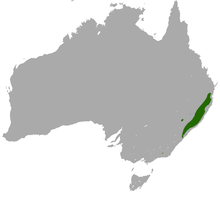Brush-tailed rock-wallaby
| Brush-tailed rock-wallaby [1] | |
|---|---|

| |
| Scientific classification | |
| Kingdom: | Animalia
|
| Class: | |
| Subclass: | |
| Order: | |
| Family: | |
| Genus: | Petrogale
|
| Binomial name | |
| Petrogale penicillata (Gray, 1827)
| |
The brush-tailed rock-wallaby or small-eared rock-wallaby (Petrogale penicillata) is a kind of wallaby. It is one of several rock-wallabies in the genus Petrogale. It lives in the rocks and cliffs of the Australia's Great Dividing Range from about 100 km (62 mi) north-west of Brisbane to the Grampians in south west Victoria. Its habitats include rainforest and dry sclerophyl forests. Numbers of brush-tailed rock-wallabies have gone down in the south and west of its range. It remains locally common in northern New South Wales and southern Queensland.[3] In Victoria the species is nearly extinct with only four in the Grampians National Park, and 20 in East Gippsland.[4][5] In 1988 at Jenolan caves in New South Wales, about 80 wallabies were released into the forest, but by 1992 there were only seven left.[4]
Introductions[change | change source]
In the late 1800s, Governor Grey introduced this and four other species of wallabies (including the rare parma wallaby) to islands in Hauraki Gulf, near Auckland, New Zealand, where they became well-established. In modern times, the wallabies have come to be viewed as exotic pests. They have caused problems for the native plants and animals and are being removed from the islands. Between 1967 and 1975, 210 rock-wallabies were captured on Kawau Island and returned to Australia, along with thousands of other wallabies.[6] Rock-wallabies were removed from Rangitoto and Motutapu Islands during the 1990s. Another 33 rock-wallabies were captured on Kawau during the 2000s, and returned to Australia.[7][8]
In 2003 some Kawau brush-tails were relocated to the Waterfall Springs Conservation Park north of Sydney, New South Wales, for captive breeding purposes.
Two wallabies escaped in 1916 on the island of Oahu in Hawaii.[9] There is now a small breeding population.

References[change | change source]
- ↑ Groves, Colin (2005). Wilson, D. E.; Reeder, D. M. (eds.). Mammal Species of the World (3rd ed.). Johns Hopkins University Press. p. 68. ISBN 0-801-88221-4.
- ↑ "Petrogale penicillata". IUCN Red List of Threatened Species. Version 2008. International Union for Conservation of Nature. 2008. Retrieved 29 December 2008. Database entry includes justification for why this species is listed as near threatened
- ↑ Menkhorst, P and Knight, F (2001). A Field Guide to the Mammals of Australia. Melbourne: Oxford University Press. ISBN 0-19-550870-X.
{{cite book}}: CS1 maint: multiple names: authors list (link) - ↑ 4.0 4.1 "Brush-tailed Rock-wallaby". The Foundation for National Parks and Wildlife. 2012. Archived from the original on 20 March 2014. Retrieved 20 November 2012.
- ↑ Smith, Bridie (1 Nov 2012). "Grampians the footing to give agile wallabies a boost". The Age. Melbourne. Victoria. p. 3.
- ↑ Shaw, W.B.; Pierce, R.J. 2002: Management of North Island weka and wallabies on Kawau Island. Department of Conservation Science Internal Series 54. Department of Conservation, Wellington. ISBN 0-478-22272-6.
- ↑ "Rock wallabies". Catalyst. ABC. 4 March 2004. Retrieved 2 March 2012.
- ↑ "Saving the Brush-tailed Rock Wallaby". Waterfall Springs Wildlife Sanctuary. Archived from the original on 19 July 2008. Retrieved 2 March 2012.
- ↑ "Brush-tailed rock walaby". birdinghawaii.co.uk. 2005. Archived from the original on 21 May 2015. Retrieved 20 November 2012.
Other websites[change | change source]
- Brush-tailed rock-wallaby recovery in NSW (Foundation for National Parks & Wildlife) Archived 2006-08-22 at the Wayback Machine
- Brush-tailed rock-wallaby population in Green Gully - a conservation case study Archived 2009-03-10 at the Wayback Machine
- Brush-tailed rock-wallaby habitat modelling Archived 2009-09-14 at the Wayback Machine
- BBC video of brush-tailed rock-wallabies in action Archived 2011-02-17 at the Wayback Machine
- The Aussie Brush-Tailed Rock-Wallaby Ark Conservation Project Archived 2021-05-13 at the Wayback Machine

